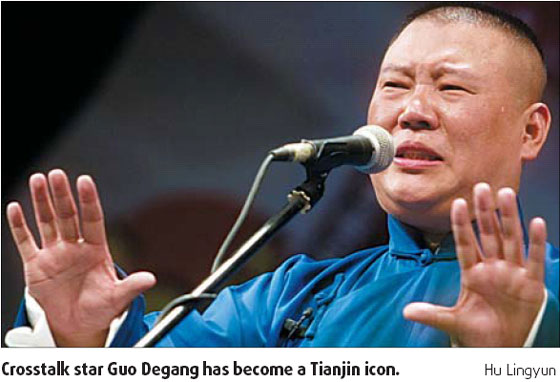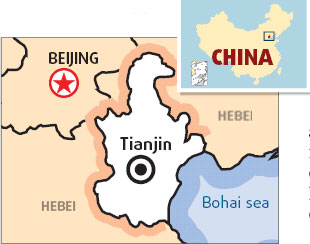Love thy neighbor in this talky town

Many colleagues envy me before the Spring Festival, for it takes only one hour's train ride from Beijing to get back to my hometown, Tianjin.
Indeed, for Beijingers, taking a trip to Tianjin is like visiting a neighbor. Although there's nothing fancy in his house, you feel comfortable there, and the more you know him, the more you want to make friends with him.
Unlike Beijing, most streets in Tianjin do not run north-south or west-east, but seem to be following their own inclinations, which makes it very easy for an outsider to get lost. Sometimes you think you are going somewhere, but you may end up at the place where you started. Bear in mind that the directions of most roads in Tianjin follow the winding Haihe River.
Another obvious difference is the dialect. According to linguistic research, the first tone in Tianjin dialect is pronounced much lower than that in putonghua, by about one octave. For an ear that is used to putonghua, the Tianjin dialect sounds like someone singing karaoke who can't hit the high notes of a song.
Tianjin is a humorous city. Many famous xiangsheng (crosstalk) performers are from here, including Ma Sanli, one of the greatest xiangsheng masters of all time, and Guo Degang, inarguably today's hottest star.
After spending time in Tianjin listening to locals talking in the bus, market and street, you will know why. People put on spontaneous xiangsheng shows any time, and the funniest xiangsheng works are based on their language.

Often described as the "most plebeian city in China", Tianjin bestows an atmosphere of contentment on its people. I remember once reading an article by a visitor to Tianjin, who said that the best-looking women in Guangzhou are those in limousines, while the most beautiful women he sees in Tianjin are those sitting on the backseats of their boyfriends' bicycles.
Tianjin was, and to some extent still is, a strange juxtaposition of local and Western cultures. On the one side there is the old downtown area with shops stocking the famous traditional brands, and on the other side there are Western buildings from the time when Tianjin was a concession of nine countries.
If you come to Tianjin, be sure to sample a little of both cultures. Go to the Gulou area to shop for traditional handicrafts, and take a walk along North Jiefang Road, where you will find buildings comparable to those on the Bund of Shanghai.
If your budget allows, stay a night at the Astor Hotel, which was built in 1863 and boasts the first lift in China, or the Peace Hotel on the quiet Dali Road, where Mao Zedong once stayed.
Although the best-known food in Tianjin is baozi (steamed stuffed buns) and mahua (fried dough twist), there is another one that I want to recommend: Gabacai is made of strips of baked mung bean flour cake with special sauces. Served at breakfast, gabacai is among the things that I miss the most in Tianjin and can't be found anywhere else.
Last but not least, go to a xiangsheng teahouse to watch grassroots performers in action. Maybe among them is tomorrow's Guo Degang.
(China Daily 01/17/2008 page19)














